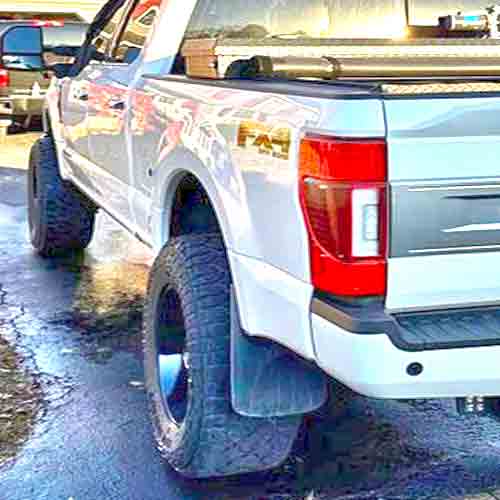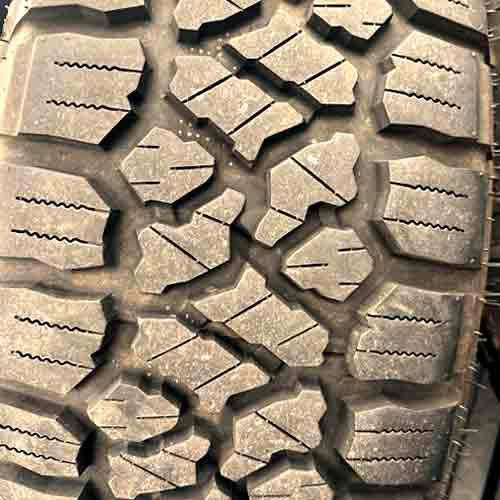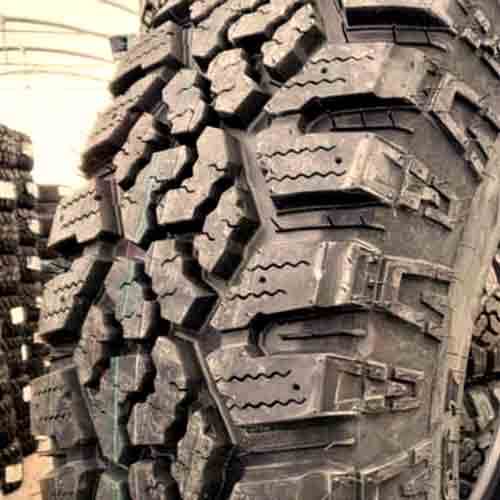The Kenda Klever AT2 and the Kanati Trail Hog, both all-terrain tires, sport a specialized all-season compound offering enhanced cut and chip resistance. They ensure seamless on-road maneuverability and dependable off-road stability. However, one tire edges out the other in certain performance aspects. Let’s see which one, and why!

Table of Contents
Sizes Specs
The Kenda Klever AT2 provides you with 15 to 20 inches rim diameters with following specs:
- Speed ratings: R, S, T and H.
- Load ratings: SL, XL, C and E.
- Weight range: 35 to 60 lbs.
- Tread depth: 14/32″ or 15/32″.
- Ratings: 3PMSF and M+S rated.
- Warranty: 50k (LT), and 60k for P metric sizes.
Review this tire in detail: https://tiredriver.com/kenda-klever-at2-review/
Kanati Trail Hog A/T, on the other side, comes in 16 to 20 inches with following specs.
- Speed ratings: Q only.
- Load ratings: E only.
- Weight range: 45 to 75 lbs.
- Tread depth: 18/32″.
- Ratings: M+S and 3PMSF.
- Warranty: No mileage warranty.
Tread Design
The Vietnamese tire, Kenda Klever AT2 features a pretty unique design, so let me talk about this tire first.

Starting form the middle, the tire shows up randomly placed lugs of various shapes and sizes.
These are actually 3 unique blocks making mirror images with each other, where the central ones (arrow-shaped), are slightly bigger but carry same rectilinear full depth sipes and off-set edges like the rest.
Together they make a web of grooves running in all directions and joining up with the outer longitudinal channels.
So this way the tire is able to provide a good deal of traction off-road.
Though it does it without compromising too much on-road grip, as there the tread offers directional stability with reinforced foundations (as all lugs are joined up with each other with the help of ridges). Though these rides also work as stone ejectors.
Moving towards the shoulders, they are pretty straight forward, equipped with wave-like sipes and have staggered margins.
On the other side, the The Kanati Trail Hog features a more aggressive design, no doubt. I mean just look at the tire.

It features clear-cut parts of the tire, the middle area, and the shoulders divided by wild zigzag circumferential rings.
The lugs in the middle are smaller and make a web of grooves connecting these outer rings, creating a very self cleaning tread (which is highly need on challenging terrains like mud).
These lugs are also very biting with their offset sides and edges, and sipes (though the sipes are not full depth).
And at the same time with their closeness they get to offer good enough on-road “directional” grip as well.
Shoulder lugs are more wildly spaced apart carrying bold stone ejectors in between.
These shoulder lugs carry more aggressive siping pattern, are stud-able and have staggered outer margins, which then extend down towards the sidewalls yielding powerful lugs over there.
Road Comfort
A tire’s comfort level on the road is influenced by various aspects, including its internal and external structure.
For instance, a tire with a softer internal construction and a flexible top rubber layer with supple lugs is more efficient in absorbing and dampening the impact of bumps and vibrations.
Now, subjectively speaking, both tires perform well in this regard.
But, due to superior on-road stability, the Kenda Klever AT2 is still a more appropriate choice for predominantly smooth pavement driving.
I mean, the tire offers better steering feedback, and steering responsiveness.
Though for rugged terrains, such as gravel and dirt-filled roads, the Kanati Trail Hog delivers a better performance with its superior “off-road impact” absorption abilities.
Wet Traction
To mitigate the risk of hydroplaning on moist roadways, tires incorporate sipes, which are basically tiny cuts/slits in the tread, which essentially absorb water particles, so the biters can grip (on a relatively dried up surface).
And while this happens, most of the water leaves out the tread through the help of grooves.
Now both tires are pretty voided up, so they offer good enough macro cleaning of the water. Though with superior siping, the Kenda Klever AT2 is still taking the lead.
The tire basically features dual siping system, which delivers a notably responsive ride.
Its central lugs bear rectilinear sipes, which offer superior braking and acceleration capabilities, while its interlocking sipes on shoulder provide superior handling times, as seen on tests.
Here, the Kanati Trail Hog, lacks with it’s missing ample siping, and wider tread voids, which causes more overall slippage on corners, relatively.
Dry Lateral Grip
During turns, the weight of the tire (and vehicle), is transferred onto the shoulders and sidewalls, the primary areas of concern for lateral grip.
I mean, shoulders contact with the road during cornering, is what mostly matters here.
And examing thse shoulders, along with the tire’s structure and composition, elucidates why the Kenda Klever AT2 presents superior handling performance.
And its design features closely spaced lugs with reinforced foundations, offering greater rubber-to-road contact from outer edges and contributing to cornering stability.
In contrast, the Kanati Trail Hog, with its larger lug gaps, cannot maintain its tread as effectively. Its lugs bend considerably more during turns, initially resulting in understeering, followed by oversteering, consequently causing delayed feedback and handling times.
Dry Directional Traction
The evaluation of directional grip assesses a tire’s traction on straight, dry roads. This is typically determined through the measurement of braking distances and acceleration times.
And one more thing you need to know, that the central portion of the tire’s tread experiences the highest weight concentration during straight-line travel. So how well that middle part contacts the road is very crucial.
Now, although both tires offer pretty closed up lug arrangement in the middle, (relatively, compared to shoulder area), the Kenda Klever AT2 still get to be better.
This is because Klever AT2 offers a more stable contact with the road, due to it’s solid reinforced foundational supports on the lugs.
Fuel Economy
Fuel consumption is influenced by various factors, though weight and tread structure, are the two most paramount ones.
And so considering these elements, it’s understandable why the Kenda Klever ranks higher.
It’s lighter and has tightly packed tread voids, which evenly distribute the weight, resulting in lower pressure per lug.
Conversely, the Kanati Trail Hog, with its aggressive tread voids, forces its blocks more against the ground. This results in increased flexing, generating higher rolling friction and fuel consumption.
Basically energy is wasted/consumed in to the bending of the lugs. And that same energy could have used in to the rolling of the tire.
Winter Grip
The proficiency of a tire in wintry conditions is determined by its ability to maintain forward momentum, navigate corners, and respond to braking on various terrains.
And upon evaluating these tires across all these performance metrics, we arrive at the following conclusions.
The Kenda Klever AT2 emerges as a superior choice on hard-packed snow, while its counterpart performs admirably on slightly deeper terrains.
The Klever A/T2 basically offers more interlocking biters, combined with dual siping design, which grip on ice much better, relatively. Moreover, for any loose snow, besides ice, its central tread area does the job perfectly.
The lugs there efficiently traps snow particles, thanks to its randomly distributed lugs, thus facilitating excellent snow-to-snow contact. (It’s significant, as snow like to adhere to snow compared to rubber).
In contrast, the Kanati Trail Hog, with its more open structure, proves more effective on deeper tracks. Though, its performance on ice could be improved with it’s stud-able lugs.
Rock Climbing
During rock climbing, robust sidewalls and an abundance of biters for grip are essential, as this activity requires both longitudinal and lateral grip.
Now, out of both tires, its clear why the Kanati Trail Hog is a much better pick here.
The tire features greater durability with its 3 ply sidewalls which allow for a more “confidence-inspiring” ride. And it’s thick lugs with multi-angled grooves provide grip in all directions.
On the other side, the Kenda Klever AT2 lacks, even with lowered air pressure, as the tire, simply put, is not as aggressive, and missing with thick voids, and biting sidewall lugs.
Mud Grip
In muddy conditions, a tire’s capacity to clear mud from its tread is as crucial as its paddling ability.
And here again, it’s unsurprising that the Kanati Trail Hog is taking the lead.
The tire offers more voided up structure, allowing wet sticky debris to leave out in all directions.
Moreover it’s thicker lugs, staggered shoulders and aggressive sidewalls provide the needed paddling, so the tire scoops its way out, even when its knee deep in mud.
In contrast, the Kenda Klever AT2’s densely packed lug design results in it becoming clogged more quickly. It struggles with efficient mud evacuation, and its smaller groove mouth isn’t adept at dislodging thick clay either.
Desert Performance
Weighing just 60 lbs at its heaviest size, the Kenda Klever AT2 exhibits excellent traction on soft sand. Its lighter weight coupled with smoother outer edges prevents the lugs from digging in, making the tire easier to maneuver.
Additionally, its sidewall lugs, although not so aggressive, occupy a larger surface area, and that’s what really matters on sand, as they expand out better and provide the tire with the needed floating abilities.
On the contrary, the Kanati Trail Hog underperforms slightly, primarily due to its heavier structural weight and sharper outer edges, which make it more prone to sinking.
I mean its odd to see this tire lacking behind, even slightly so, but it is what it is.
So what’s the verdict?
In conclusion, the choice between the Kenda Klever AT2 and the Kanati Trail Hog depends on the intended application and driving conditions. I mean both tires have their strengths and weaknesses across different terrains and driving situations.
The Kenda Klever AT2 outperforms in wet and dry traction, with its superior siping providing an excellent grip on moist roadways and improved handling.
Furthermore, it performs better in wintry conditions, specifically on hard-packed snow, and offers superior fuel economy due to its lighter weight and tightly packed tread voids.
This tire also provides a more comfortable ride on smooth pavement and shows excellent traction on soft sand, making it ideal for most road driving conditions and desert performance.
On the other hand, the Kanati Trail Hog shines in challenging off-road conditions. Its robust sidewalls and abundance of biters make it an excellent choice for rock climbing.
Moreover, its aggressive tread voids and thicker lugs provide superior performance in muddy conditions and deep snow terrains.
Although it consumes more fuel due to its aggressive tread voids and higher weight, it offers excellent off-road impact absorption abilities and performs better on rugged terrains.